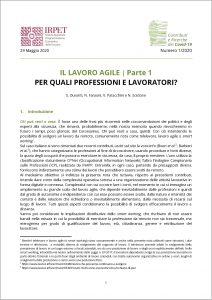SMART WORKING – part 1: for which jobs and workers?
Contributi e Ricerche del Covid-19 Numero 1
S. Duranti, N. Faraoni, V. Patacchini e N. Sciclone
Thousands of people are being forced to work from home during the Coronavirus outbreak. An important issue to assess the effects of the pandemic on employment, is how many individuals can work from home. This report proposes a methodology to identify the share of jobs that can be performed in a smart working mode in Italy, using data from a sample survey on occupations carried out by INAPP. We find that the share of individuals who can work from home is 32,6% in Tuscany, with some territorial heterogeneity due to economic specializations. We also document considerable variation in the potential to work from home across industries and workers’ socioeconomic characteristics; women, native and mature workers are more likely to be employed in teleworking occupations, as well as workers in advanced services. This paper also identifies workers of essential and non-essential industries that could work from home during the period of lockdown, limiting the risk of contracting Covid-19 while continuing to earn a salary.










